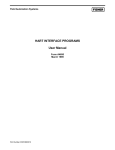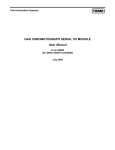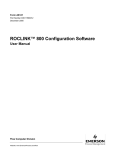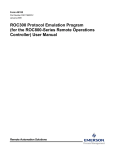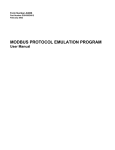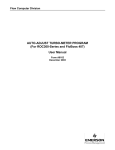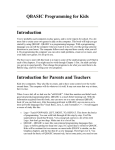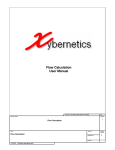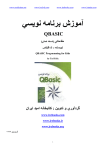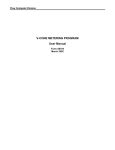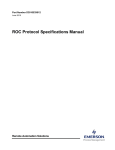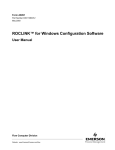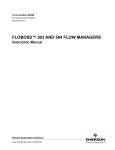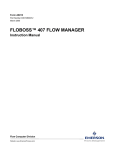Download to the PDF file.
Transcript
Flow Computer Division ULTRASONIC SERIAL I/O INTERFACE User Manual (QER 02Q017) Form A6133 February 2003 Ultrasonic Serial I/O Interface Revision Tracking Sheet February 2003 This manual may be revised from time to time to incorporate new or updated information. The revision level of each page is indicated at the bottom of the page opposite of the page number. A change in revision level to any page also changes the date of the manual that appears on the front cover. Listed below is the revision level of each page. Page Revision Cover, ii, and 1 All other pages 2 (2/03) 1 (6/02) (Note: This manual is based on Vinson Controls’ Ultrasonic interface software.) Daniel, SeniorSonic, JuniorSonic, FloBoss and ROCLINK are marks of the Emerson Process Management companies. The Emerson logo is a trademark and service mark of Emerson Electric Co. All other marks are the property of their respective owners. Fisher Controls International, Inc. 2002-2003. All rights reserved. Printed in the U.S.A. While this information is presented in good faith and believed to be accurate, Fisher Controls does not guarantee satisfactory results from reliance upon such information. Nothing contained herein is to be construed as a warranty or guarantee, express or implied, regarding the performance, merchantability, fitness or any other matter with respect to the products, nor as a recommendation to use any product or process in conflict with any patent. Fisher Controls reserves the right, without notice, to alter or improve the designs or specifications of the products described herein. Rev. 1 2 ii Ultrasonic Serial I/O Interface Table of Contents Page 1 Introduction............................................................................................................................................ 1 2 Downloading the Serial I/O Program .................................................................................................... 2 2.1 Program Download Requirements.......................................................................................... 2 2.2 1 Program Download Procedure For ROCLINK for Windows.............................................. 2 3 Ultrasonic Meter Interface Operation .................................................................................................... 4 3.1 Hardware (Serial I/O module) ................................................................................................ 4 3.2 Module Types and Wiring Methods ....................................................................................... 5 3.3 Communication Modes........................................................................................................... 5 4 Program Configuration .......................................................................................................................... 5 4.1 Modbus Polling Screen ........................................................................................................... 6 4.2 Sonic Reads Screen................................................................................................................. 7 4.3 Sonic Writes Screen.............................................................................................................. 10 Rev. 1 iii Ultrasonic Serial I/O Interface [This page is intentionally left blank.] Rev. 1 iv Ultrasonic Serial I/O Interface 1 INTRODUCTION The components of this Ultrasonic Meter Interface application (identified as 02Q017) are: ♦ The Serial I/O Module with embedded ultrasonic application ♦ A user program for handling the Serial I/O Module ♦ This user manual (Form A6133). The Serial I/O Module, programmed at the factory with the Ultrasonic Meter application, provides an interface between ROC300-Series with FlashPAC or FloBoss 407 units and a Daniel Ultrasonic Meter (USM). The Module polls the meter, retrieving flow and diagnostic information. The application allows communication with up to four multi-dropped Ultrasonic Meters. This application assumes that pressure and temperature transmitters are wired directly to the ROC300Series or FloBoss 407 unit. The Pulse Input from each Ultrasonic Meter is also wired to the ROC or FloBoss to provide it with an uncorrected pulse rate. The ROC/FloBoss takes these inputs and performs AGA7 and AGA8 calculations to provide the corrected flow. The Serial I/O Module only provides the ROC/FloBoss with K-factor and diagnostics information. The actual flow calculation is always performed by the ROC/FloBoss. The ultrasonic meter interface, which is embedded by the factory in a Serial I/O Module (RS-485), allows the ROC/FloBoss to communicate with a Daniel Ultrasonic Meter without requiring a communications port to be used. This manual describes how to install the application-independent Serial I/O User Program (.H00 file) into the ROC/FloBoss, which requires it for operation with the Serial I/O Module. The manual also describes the logic and configuration of the ultrasonic application that is factory-loaded into the Serial I/O Module. The user program is downloaded to a ROC300-Series unit with FlashPAC or to a FloBoss 407 by using the ROCLINK for Windows Configuration Software (version 1.01 or greater). Although not discussed in this manual, it is also possible to download the program using ROCLINK Configuration Software (for DOS, version 2.20 or greater). The user program can be installed in ROC300-Series with FlashPAC units (version 2.10c or greater) or in FloBoss 407 units (version 1.04 or greater). This manual assumes that the user is familiar with the ROC300-series with FlashPAC or FloBoss 407 units and their configuration. For more information, refer to the appropriate ROC300-Series or FloBoss 407 instruction manual and the ROCLINK For Windows Configuration Software User Manual (Form A6091). Rev. 1 2 1 Ultrasonic Serial I/O Interface 2 DOWNLOADING THE SERIAL I/O PROGRAM The Serial I/O User Program handles the communication between the Serial I/O Module and the ROC or FloBoss. The user program, which is application-independent, consists of a downloadable .H00 file. It allows user-defined points (defined by the module) to be created and maintained in the ROC/FloBoss. It also has the ability to read and write standard point type parameters in the ROC. NOTE: A PC-compatible computer must be connected to the comm port before downloading is started, and RAM must be available in the intended download area. 2.1 Program Download Requirements The Serial I/O program is downloaded to, and then run from Flash and RAM memory in the ROC or FloBoss unit. The following information shows the requirements for downloading and running the user programs. Program ROC or FloBoss Device Code at Data at SIO_D8B8.H00 ROC300 FlashPAC D800 B800/BC00 SIO_7060.H00 ROC300 ROCPAC or FloBoss 407 7000 6000/6400 SIO_D0D8.H00 ROC300 ROCPAC D000 D800/DC00 SIO_D0B0.H00 ROC300 FlashPAC D000 B000/B400 SIO_C0C8.H00 ROC300 ROCPAC C000 C800/CC00 SIO_B8A8.H00 ROC300 FlashPAC or ROCPAC B800 A800/AC00 SIO_B060.H00 FloBoss 407 B000 6000/6400 Only one of the programs is required. The downloadable program names are all run in User1 task (except SIO_D8B8.H00 which runs in Task 3). For information about viewing the memory allocation of user programs loaded in the ROC or FloBoss, refer to the ROCLINK For Windows Configuration Software User Manual (Form A6091). 2.2 1 Program Download Procedure For ROCLINK for Windows This section provides instructions for installing the Serial I/O User Program into ROC or FloBoss memory. To download the Serial I/O User Program: 1. 2. 3. 4. Rev. 1 Connect the ROC or FloBoss to your PC through the LOI port. Logon to ROCLINK for Windows. Connect to the ROC300-series or FloBoss 407 unit. Select Utilities from the ROCLINK menu bar. Select Download User Programs. The User Programs dialog box will appear. See figure 2. 2 Ultrasonic Serial I/O Interface Figure 2. User Programs Dialog Box 5. Click the Choose Files pushbutton. A dialog box appears. Use the Open dialog box to navigate to the file with the .H00 extension. When the desired program appears in the File Name field, select it and click OK. 6. Click the Download pushbutton to begin loading the selected programs. See figure 3. When the program has been downloaded, the following occurs: ♦ The program is automatically turned ON ♦ A Warm Start is automatically initiated ♦ A record is created in the Event Log. Figure 3. ROCLINK User Program Installation 8. To restart the program in the event the program becomes inactive, such as after a cold start, select Flags from the ROC menu to display the ROC Flags dialog box, shown in Figure 4. Rev. 1 3 Ultrasonic Serial I/O Interface Figure 4. ROC Flags Dialog Box 9. To activate the Serial I/O program, set the appropriate Com User Program flag to Active. 10. Click Apply. 11. Set the Write to Internal Config Memory flag to Yes. This ensures that when a Cold Start is performed, the User Program automatically starts. 12. Click Apply. Refer to the ROCLINK for Windows Configuration Software User Manual (Form A6091), for additional information concerning User Programs. 3 ULTRASONIC METER INTERFACE OPERATION 3.1 Hardware (Serial I/O module) The application is embedded in a Serial I/O Module. The module contains an 8-bit Motorola Microcontroller with 1K RAM and a 32K external EEPROM. The Microcontroller’s CPU handles the communications with the ultrasonic meter, processes the application logic and builds the data messages for the ROC. This modularity off-loads these tasks from the ROC CPU. The only load on the ROC is when the user program exchanges data with the Serial I/O Module. The Serial I/O Module can be placed into any I/O module slot in the ROC. The user program will support up to ten Serial I/O Modules. Rev. 1 4 Ultrasonic Serial I/O Interface 3.2 Module Types and Wiring Methods The RS-485 module can be used for distances of up to a few thousand feet. This module supports multiple field devices (multi-drop). It uses two conductors ( +, -) connected to terminals A and B as shown below. SERIAL I/O RS-485 O A B C 3.3 + – N/C Communication Modes The Ultrasonic Serial I/O Interface uses Modbus protocol to communicate to the ultrasonic meter. The module acts as a Modbus master and polls the meter for the required floating point and integer registers. The module can communicate at rates up to 9600 baud. The application communicates using Modbus RTU protocol. The Ultrasonic Serial I/O Interface creates a user-defined point in the ROC or FloBoss. User-defined point number 27 is created for the values in the UFM Modbus Polling screen. User-defined point number 28 is created for the values in the Sonic Reads screen. User-defined point number 29 is created for the values in the Sonic Writes screen. For more information on these screens, refer to Section 4. The program also provides alarming capability. Alarms are entered in the ROC alarm log for: communications errors with the meter and any alarm code received from the meter. The alarm bits are set on the Sonic Reads screen (see Section 4). 4 PROGRAM CONFIGURATION This section describes the configuration of the Ultrasonic Serial I/O user program. These screens are accessed by opening the user program through ROCLINK for Windows software. The Ultrasonic Serial I/O Interface user program has three screens: UFM Modbus Polling, Sonic Reads, and Sonic Writes. Values shown in the figures below are the program defaults. NOTE: After the program has been configured with the desired values, the user should perform a Warm Start procedure to save the desired configuration. A Warm Start should also be performed after changing any fields on the Modbus Polling screen. Otherwise, the change will not be processed until the next power cycle. Rev. 1 5 Ultrasonic Serial I/O Interface Figure 5. UFM Modbus Polling Screen 4.1 Modbus Polling Screen The module allows communications with up to four Ultrasonic Meters. The UFM (Ultrasonic Flow Meter) Modbus Polling screen sets the polling parameters (see Figure 5). A UFM Address that is zero will not be polled. All four addresses default to zero. To initiate polling the address field should be set to the address of the meter. The communications settings can remain at the defaults: 9600 baud, 8, 0, 1. The Key-on delay and keyoff delay default settings are 2, 1. These are in l6ms periods. The Resp Timeout is in seconds (default=1) and must be a whole number. The Reset Comm Counter field is normally 0. If you want to reset the counters, set this field to a 1 and perform a Warm Start. The counters are Valid Receipts and Total Polls. A Warm Start should be performed after changing any fields on the Modbus Polling screen. Otherwise, the change will not be processed until the next power cycle. Figure 6. Sonic Reads Screen Rev. 1 6 Ultrasonic Serial I/O Interface 4.2 Sonic Reads Screen The Sonic Reads screen has four instances for each of the possible four meters polled. The polling is done once per minute for each meter (15 seconds apart if using four Ultrasonic meters). Six polls are done during each read: Path Status for Chords A-D, Sound Velocity for Chords A-D, Flow Data Quality, Real-Time Clock, Validities, and Pulses per Actual Cubic Foot (ACF). Alarm entries will be created in the ROC or FloBoss database, when the conditions specified by the Alarm Enable bits are met. If an Alarm is enabled it will be written to the Alarm log when set and cleared. It could also trigger an SRBX communication if so configured. As shown in Figure 6, the Most Significant Bit (MSB) is on the left and the Least Significant Bit (LSB) is on the right. While the Alarm Enable bits are defined as follows: Alarm Enable 1: Bit 0: Chord Status A (Any value greater than zero is an alarm). Bit 1: Chord Status B (Any value greater than zero is an alarm). Bit 2: Chord Status C (Any value greater than zero is an alarm). Bit 3: Chord Status D (Any value greater than zero is an alarm). Bit 4: Data Quality (Any value greater than zero is an alarm). Bit 5: Frequency Validity (zero is an alarm; one is clear). Bit 6: Temperature Validity (zero is an alarm; one is clear). Bit 7: Pressure Validity (zero is an alarm; one is clear). Alarm Enable 2: Bit 0: AGA8 Base Validity (zero is an alarm; one is clear). Bit 1: AGA8 Flow Validity (zero is an alarm; one is clear). Bit 2: Communications Failure Bits 3-7: Unused. Any of these alarms may generate an SRBX communication if the SRBX field “SRBX Mode N;B;S;C” is set to a “B”, “S” or “C”. These letters are defined as: N = SRBX on Neither Set nor Clear B = SRBX on Both Set and Clear S = SRBX on alarm Set only C = SRBX on alarm Clear only NOTE: The SRBX will be sent out of either comm. port (1 or 2) that has SRBX enabled. The actual alarms are generated from the fields on the Sonic Reads screen. The first five alarms return integers. The integer value is derived from a bit-weighted list, where each bit represents a different alarm condition. The integer is displayed on the Sonic Reads screen. The second five alarms are twostate numbers. Either a zero (invalid) or one (valid) displays on the Sonic Reads screen. The Ultrasonic Communications Failure alarm is generated when the number of consecutive (serial IO module – Ultrasonic meter) failed poll sequences is equal to or greater than the number listed in “UFM Comm Fail Limit”. A poll sequence can consist of up to six individual poll blocks (a Sonic read). If any of the blocks of a sequence fail, the sequence is counted as failed. Rev. 1 7 Ultrasonic Serial I/O Interface Polling Block #1 is the Chord (Path) Statuses A-D. Path status alarms are useful in indicating bad flow conditions (turbulence, liquid slugs, etc.) or transducer problems. Status Paths A-D pertain to the four chords in a Daniel SeniorSonic meter. If the user has a Daniel JuniorSonic meter, then only paths A and B exist and Paths C and D will always display zero. The values displayed here are 16-bit integers. The number is derived by bit-weighting the alarms (i.e. Bit8 is worth 256; Bit12 is worth 4096). The Chord Status alarm bits are defined as follows: 0 = no error bit 0 set = reject signal due to noise level bit 1 set = reject signal due Signal-to-Noise Ratio bit 2 set = reject signal if measurement quality check failed bit 3 set = reject signal if speed of sound out of range bit 4 set = reject signal if delta time check failed bit 5 set = reject signal for span check failure bit 6 set = spare bit 7 set = reject chord if flow profile check failed bit 8 set = reject signal if peak pulse width exceeds limit bit 9 set = reject signal due to signal quality bit 10 set = flow change indicator bit 11 set = reject chord if intra-chord quality check out of range bit 12 set = reject chord if speed of sound deviation out of range bit 13 set = chord is manually set to be inactive bit 14 set = chord failed bit 15 set = acquisition mode. Polling Block #2 is the Sound Velocities for Chords A-D. These are the measured sound velocities (speed of sound), in meters per second, at each of the four chord pathways A-D. The sound velocity number displayed will vary based on the density, pressure and temperature of the flow media. However, all four sound velocities should be very close to the same (fractions of one m/s). If any of the numbers is very different from the others (especially when flowing), it indicates a problem. Polling Block #3 is the Flow Data Quality. This field is long integer (32-bit) bit-weighted field. Only 17 of the 32 bits actually represent alarm conditions. The field can display several chord and memory errors: 0 = all four chords working bit 0 set = Chord A failed bit 1 set = Chord B failed bit 2 set = Chord C failed bit 3 set = Chord D failed bit 4 to 7 = reserved bit 8 to 16 are mapped to SystemStatus bits 0 to 8. bit 8 = reserved bit 9 set = Pulse accumulation error bit 10 set = HC11 RAM memory error bit 11 set = HC11 Program memory error bit 12 set = EEPROM CRC check failed bit 13 set = DSP Program memory error Rev. 1 8 Ultrasonic Serial I/O Interface bit 14 set = DSP Y-memory error bit 15 set = DSP X-memory error bit 16 set = number of operating chords below desired amount NOTE: For this field as well as the Path Status fields, an alarm is set when the value goes greater than zero. Another alarm will not generate if the field then changes value to another non-zero number (indicating an additional or different alarm). Polling Block #4 is the Real-Time Clock. The values in these fields display the date and time from the ultrasonic meter’s real-time clock. The clock display is useful for determining that the Roc-ultrasonic communications are current. When communications have failed, the clock will show the time of last valid communications. NOTE: The Year is displayed as a two-digit number. Polling Block #5 consists of the Validity fields. These five fields will display ones (1) in normal operation. A zero (0) in any of these fields, especially Frequency Validity, indicates a significant error condition. In this condition, the ultrasonic meter is unable to determine the correct flow rate, and therefore is unable to generate the correct frequency output (flow rate). Polling Block #6 is Pulses per Actual Cubic Foot (ACF). This field displays the K-Factor from the ultrasonic meter. Be sure that the ultrasonic meter is configured to use U.S. units (pulses per cu.ft3). The conversion factor field of the corresponding Pulse Input in the ROC or FloBoss unit should be set to match this value multiplied by 1000 (x 1000). NOTE: The conversion mode of the corresponding pulse input should be set to “EUs/Pulse”. The six “Comm Status” fields pertain to the six poll blocks mentioned above. When all the Comm Status fields display 8, communication is successful on all polling blocks. The result codes are: 1 = No Response 11 = Invalid Response (address) 2 = Partial Response Only 8 = Good Response The “Total Polls” field counts the total poll blocks (requests) sent out for the entire Sonic Reads screen. The “Valid Receipts” field counts the valid responses received for the entire Sonic Reads screen. The two fields can be reset (set back to zero) by entering a “1” in the “Reset Comm Counters” field on the UFM Modbus Polling screen. These two fields are useful for analyzing communications success rates. Rev. 1 9 Ultrasonic Serial I/O Interface Figure 7. Sonic Writes Screen 4.3 Sonic Writes Screen The Sonic Writes screen shows the values in the ROC that are written to the USM. Four polls are done for each USM once per minute. Two of the Write polls (block #3 and 4) are done every second with the Read poll blocks. The other two Write polls (blocks #1 and 2) are done as time permits between the Read polls and Write poll blocks #3 and 4. In a one meter configuration, Write polling will be completed practically every second. In a four meter configuration, Write polling may take 4 seconds to complete. The intent of the sonic writes is to send the ultrasonic meter all the information it requires to do a corrected flow volume for its own historical (audit) log. This gives the capability of having additional EFM logs on-site (the newest ultrasonic boards can do AGA8/AGA7 corrected flow and archival). Write Poll Block #1 consists of the Specified Flow fields. Specified Flow Temperature is the temperature reading (specified to the Ultrasonic meter) from the corresponding AGA data structure in Roc memory. It is transmitted as Modbus register 10134/10135. Specified Flowing Pressure is the pressure reading from the corresponding AGA data structure in ROC memory. It is transmitted as Modbus register 10136/10137. Write Poll Block #2 consists of the Rho Mix, Z Flow and Z Base fields. Rho Mix is the Flowing Density. It is transmitted as Modbus register 10078/10079. Z Flow is the Z Factor at flowing conditions. It is transmitted as Modbus register 10080/10081. Z Base is the Z Factor at base conditions. It is transmitted as Modbus Register 10082/10083. Write Poll Block #3 consists of the Atmos Pressure, HCH Method, BTU, Ref Temp HV, and Specific Gravity fields. Atmos Pressure is the Atmospheric Pressure value. It is transmitted as Modbus register 10104/10105. HCH Method is the AGA8 Gross Characterization method. ‘0’ is the value sent. This value is hard-coded in the Serial I/O module. This field is actually sent as filler in the Modbus string between Atmos Pressure and Specific Gravity. It is transmitted as Modbus register 10106/10107. BTU is the heating value. It is transmitted as Modbus register 10108/10109. Ref Temp HV is the reference temperature for the volumetric gross heating value. This value is hard-coded in the Serial I/O module as “60”. This field is actually sent as filler in the Modbus string between Atmos. Pressure and Specific Rev. 1 10 Ultrasonic Serial I/O Interface Gravity. It is transmitted as Modbus register 10110/10111. Specific Gravity is the Specific Gravity value. It is transmitted as Modbus register 10112/10113. Write Poll Block #4 consists of the Mole Fraction N2 and Mole Fraction CO2 fields. Mole Fraction N2 is the Nitrogen mole percentage. The value is divided by 100 before it is sent to the ultrasonic meter. It is transmitted as Modbus register 10122/10123. Mole Fraction CO2 is the Carbon Dioxide percentage. The value is divided by 100 before it is sent to the ultrasonic meter. It is transmitted as Modbus register 10124/10125. The four “Comm Status” fields pertain to the four poll blocks mentioned above. When all the Comm Status fields display 8, communication is successful on all polling blocks. The result codes are: 1 = No Response 11 = Invalid Response (address) 2 = Partial Response Only 8 = Good Response Be sure to check Save to Internal Config Memory when performing a Warm Start in the ROC Flags screen in ROCLINK software, after configuring the screens in the Ultrasonic Serial I/O user program. Rev. 1 11 Ultrasonic Serial I/O Interface If you have comments or questions regarding this manual, please direct them to your local sales representative or contact: Emerson Process Management Flow Computer Division Marshalltown, IA 50158 USA Houston, TX 77065 U.S.A. Pickering, North Yorkshire UK Y018 7JA Website: www.EmersonProcess.com/flow Rev. 1 12

















